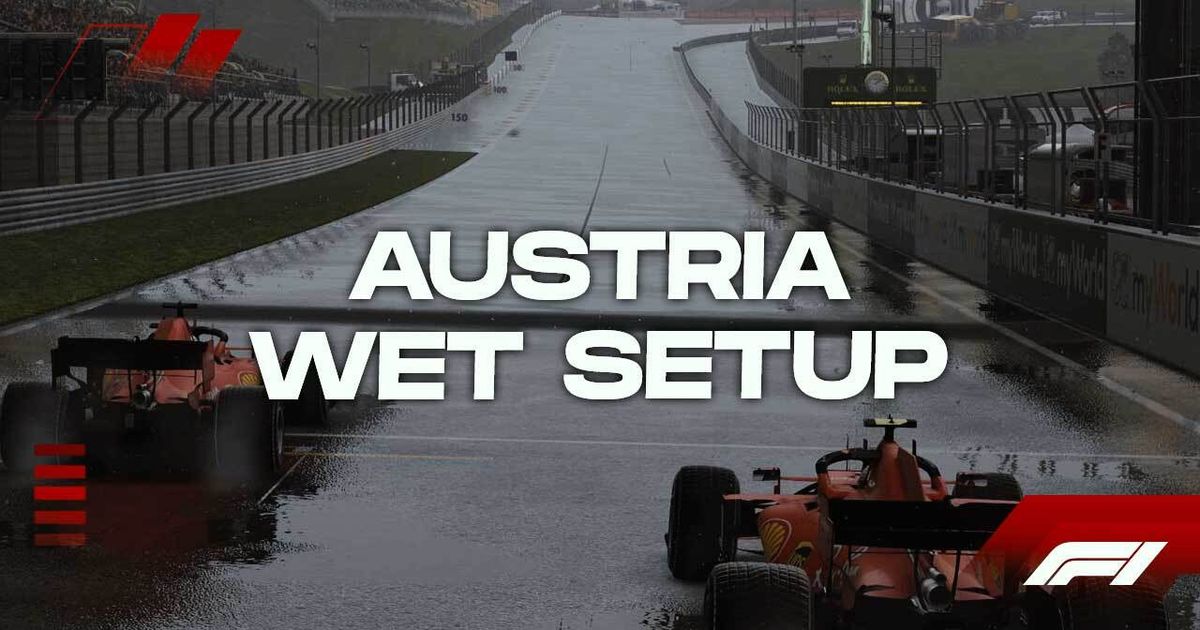The Red Bull Ring at Spielberg has played host to both the Austrian and the Styrian Grands Prix in 2020. The Styrian hills surrounding the track make for a gorgeous backdrop, and the racing is always enthralling.
Table of Contents
This is a simple track in the dry. In the wet, it becomes far more interesting. Rain is always a distinct possibility around here, and it pays to be prepared for it. What better way to prepare than to have a tailor-made setup for those very conditions?
Aerodynamics
As with any wet setup, stability is the main goal. There are several ways to achieve a stable car, but the wings are the best place to start.
Running 4-9 will give you plenty of front-end grip for the second and third sectors, while the high rear wing setting will make sure the rear of the car stays planted under acceleration.
Transmission
For your on-throttle differential, go for 50%. This is my recommendation at every circuit, in every condition. Doing so helps so much with smooth traction, and will make driving the car far easier.
Off-throttle is a different matter. I would recommend 60%, as I’ve found that running a higher setting than this does little to benefit stability. A low setting also helps to rotate the car through the hairpin at turn 3.
Suspension Geometry
Lower (I.E. closer to 0) amounts of camber lead to a more drive-able car.
Therefore, running the maximum settings of -2.50 and -1.00 works the best at a wet Spielberg.
Running minimum toe settings is, as per usual, the optimal choice. 0.05 and 0.20 give you great grip through the longer corners. The reduction in tyre wear levels is also pretty handy.
Suspension
A soft front suspension helps a great deal with any circuit where you ride the kerbs. The Red Bull Ring is one of these tracks.
Because of this, I would recommend 1-5 for your suspension settings. You will have plenty of turn-in even with the soft front setting, and running a somewhat stiffer rear end helps with stability under traction.
The anti-roll bar settings are open to interpretation. Many people run many different options, particularly with the front anti-roll bar.
READ MORE: F1 2020 Austrian Grand Prix setup
For me, 4-10 gives the best balance. I don’t find myself to be struggling with roll through the corners, and the car seems stable and dependable.
The ride height setup is also designed with stability in mind. Going all the way to 11-11 helps the car glide along the circuit. Intermediate conditions will almost feel like a dry track. This also helps to clear all of the kerbs around the circuit.
Brakes
As in nearly every one of my setup guides, I am going to suggest a brake pressure setting of 100% and a brake bias of 50%.
Running the maximum brake pressure gives your car incredible stopping power. Any potential issues with front locking are offset by running the rearward bias.
Tyres
Wet conditions always require slightly under-inflated tyres.
Austria is no different. I’ve found that 21.8psi for the fronts and 19.9psi for the rears works really well, but others would suggest running these even lower.
It’s all about finding what works best for you, although I wouldn’t recommend running pressures much higher than I’ve recommended.
READ MORE: The best steering wheel for F1 2020
This circuit is actually very fun to drive in the wet. Certain parts of the track which are simple in the dry become more interesting in the wet.
Because of the short lap around here, it’s easy to find your groove. With this setup, it will be even easier for you to find.
Explore new topics and discover content that's right for you!




